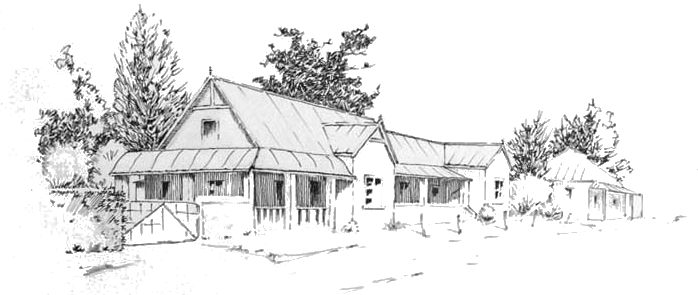– Being an essay on discovering new and remote small stream fishing grounds, fishing small streams in testy conditions, and making the unexpected and surprising revelation that bamboo fly rods beat anything else on tiny waters. Text and images (unless otherwise stated) by Greg Carstens...
With the recent spate of droughts, small stream fly fishing hasn’t been an easy pursuit, and with recent weather cycles, current conditions are at a low point, not that this has distracted me from the enjoyment of staying connected to small streams by tying up flies, reading books and the like.
Sooner or later though, I reach a point where it’s time to go fishing, but in order to warrant heading off hundreds of kilometres to remote mountain streams requires some justification. So with precious little time to fish anyway, I try my best to plan things as well as I can, to take each and every trip at the most opportune time. But all told, looking back over the last couple of years things seem to have slowly slipped from bad to worse. I could blame this on my poor trip timing or just the weather. Either way, tough conditions can test one's faith in what at best can anyhow be a somewhat fickle, challenging and unpredictable pursuit.
Now I agree with the sentiment that a bad day's fishing is better than a good day doing whatever it is that pays the bills, and although, as has been said so many times, if it was only about the fish it would be called catching and not fishing. But there are so many facets to spending a day on a stream in the company of a fine fly rod. At its simplest, bad fishing days are when you only catch a couple of fish and good days are when you stop counting. But whatever, clean air, solitude, birds, scenery and the surrounds always fill in the picture nicely, though I do need to know that there are at least a few fish about, and if I can’t catch them, that it’s because I’m a lousy fly fisher and not because there are simply no fish to catch. The former I can swallow, but knowing that a stream has seen consecutively rough seasons with flows so poor even the locals aren’t sure the trout are actually there anymore is challenging. Then I have to start swallowing a little harder and balance my need to fish small streams against my fear of damaging whatever remaining breeding stock there may be. That can really eat at my enthusiasm. I seems, though, that when I really like something I stick with it through thick and thin, part determination and part stubbornness. A love of small streams is a sentiment surprisingly few people fully understand and yet it's helped to get me this far and as I fast approach the downhill side of midlife at 45, these are the traits that have seen me through thick and thin, no matter how misguided.
I could depress you with the torment of my last few outings, the most noteworthy being a day on the Molenaars River outside Cape Town last December that pushed the mercury to 42 degrees Celsius leaving me watching a bone thin 16 inch trout slowly swimming in a death roll. Deeply saddened I could see the headlines reading “Fly fisherman and trout both die of heat stroke in Cape mountain stream”. When I made it back to the car I considered sucking the remaining moisture out of the felt on my wading boots just to moisten my tongue.
But regardless of all the doom and gloom I try my hardest to head out to Rhodes and Barkly East each autumn and spring, largely ignoring the host of cheerless critics. I simply love the region and I accept that fish may be few and far between when times are hard, and flows are as low as they have ever been, I still find an irresistible magic in the streams and valleys surrounding these towns. So, as usual, I got in touch with Dave Walker in Rhodes and although the flows were good thanks to late rains, which I thought would be the tipping point for me, he said the fish had taken a pounding and kindly sent me the catch returns for the annual Wild Trout Association fly fishing festival held in March. This is the kind of honesty you can rely on from the locals up there, and much like the economy, things looked bleak. I’ve never been a numbers person, but it seems there were nearly more fishermen than fish caught. There was the outside possibility, of course, that 40 or so of South Africa’s top small-stream fly fishers simply had a collectively bad run, but that was a little hard to sell even to myself. The silver lining was that there were still a few trout in the streams and they would repopulate in a season or two, so not all was lost considering things in the longer term. I contacted Karien Vosloo of Birkhall and hastily booked my usual accommodation as the hunting season was fast approaching. But by now the little optimism I clung to of heading out that way was rapidly fading.
Then I grabbed my dog-eared copy of Shadows on the Stream Bed written by my friend Tom Sutcliffe and re-read the chapter about Vrederus and the valleys over the hill from Rhodes and decided, after a lengthy debate with myself, that the time had come to broaden my horizons, which lead to a chat with Juan-Marie Naude of Vrederus about the fishing conditions in her part of the world on the other side of the Drakensberg to Rhodes. I was told that the drought hadn’t hit quite as hard and some streams, although not in prime shape, still held fish and that recent reports indicated that a dozen fish day was not beyond imagination. News like this was all I needed to hear. As a fly fisherman and a human being I cling to hope and live each day in faith, so with the possibility of a few wild trout, discovering new and relatively untouched streams, I had committed before I knew it.
On this trip I was joined by my brother-in-law, Ryan. It was his really first serious shot at small-stream fly fishing and although he had fished the Sabie River a number of years back, I had no doubt that his first exposure to the Eastern Cape highlands would blow his hair back a little. And because he knew the basics, the agreement was that I would stock him up with tackle and flies, leave him to his own devices and set him free in the wilderness, leaving me to do what I do best – getting completely lost in the solitude of the valleys and the streams.
Vrederus lies some 60km from Rhodes over the Naude's Nek Pass, a remote, rugged dirt road that, with stops, can easily take two hours to cover. I travelled via Rhodes, not the alternative route through Maclear, because this is the route I know, and simply because I wanted to see those valleys around Rhodes again. Crossing the Karringmelkspruit outside Lady Grey the river looked in fine shape.
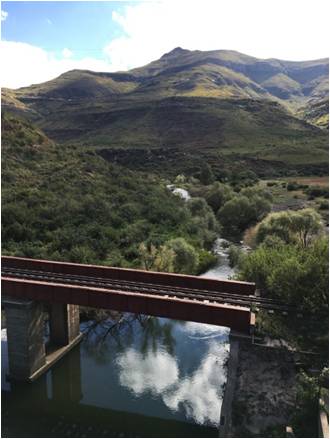
The Karringmelkspruit in fine flow outside Lady Grey
Further on we found the Kraai was pumping along, so it was no surprise to see that the source of this river at the old iron bridge over Moseshe’s ford was flowing strongly, with the Bell full of colour and the Sterkspruit slightly milky.
Click in images to enlarge

The source of the Kraai at Mosheshe's Ford, with the Bell coming in left and the Sterkspruit on the right. Tom Sutcliffe photograph.
In previous Aprils, water conditions like these would have turned me wide-eyed with happiness, as these are the streams of my dreams and it filled my heart with warmth to see them flowing well again and to know that the remaining trout will recover and eventually flourish. As you get a little older you live long enough to see the balances in life and nature shift before your eyes and sooner or later the optimist realizes that what goes down will sooner or later come up, although this doesn’t seem to apply to economics. In the end the trick is being around long enough to see it all unfold. The trout in these parts were first stocked in the 1920’s and these fish have lived through tough times before. The problem lies more with us the human animal. We have become accustomed to expecting instant gratification and quickly vent our displeasure when things aren't always available. So, as far as this part of the world is concerned, I would just have to be a little patient.
We made Rhodes by midday and although I wanted to stop at Walkerbouts Inn to greet Dave Walker I knew all too well that this spot, universally known as the Centre of the Universe, has a subtle way of swopping time for cold beer and I wasn’t sure what the road conditions would be like on the Naude’s Neck Pass. I opted for the sober drive. Ryan was less impressed by my choice of passing up on a cold beer, but the road that leads up and down this pass is a fantastic but dodgy drive, full of switch backs, loose gravel and breathtaking views and we soon both forgot about the missed beers. Simply crossing the pass is highly recommended on its own merits, never mind viewing the streams that tumble freely in each valley below, streams that are home to wild trout.
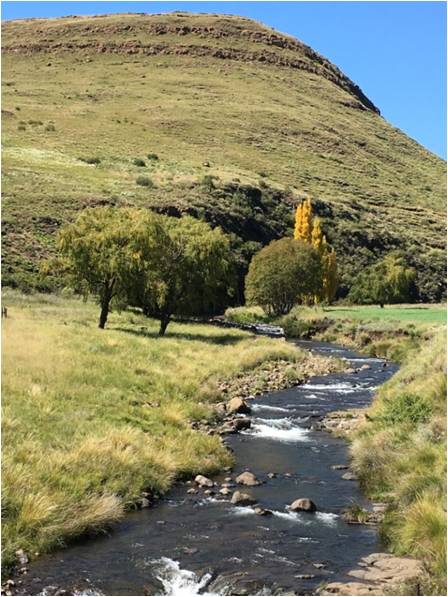
The Bell River above Rhodes flowing beautifully alongside the road up the pass.
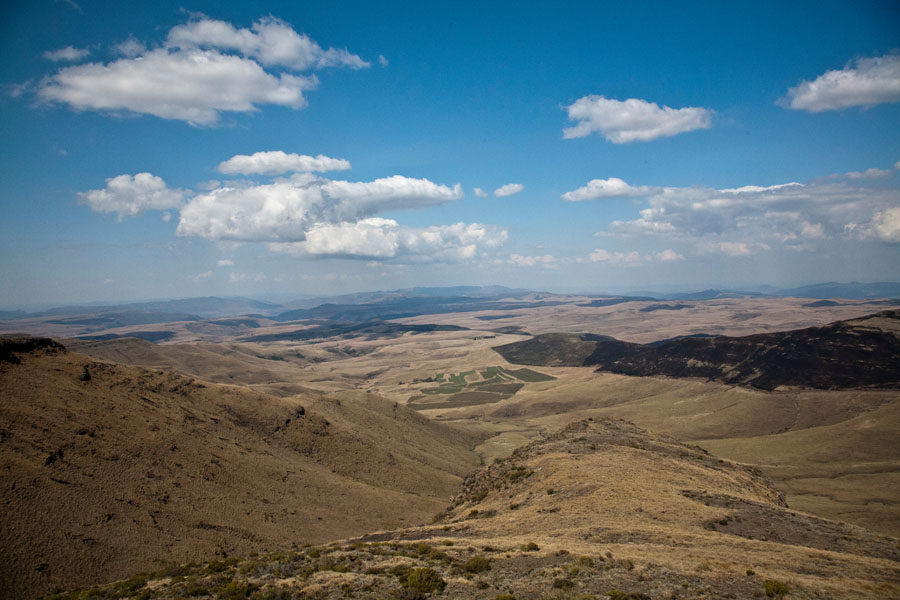
View from the summit of the Naude's Nek Pass. Tom Sutcliffe photograph.
At the outset I would like to say that I had to remind myself not to compare the two sides of the pass. You need to view each on its own merit. This is partly because I dearly love the valleys around Rhodes and Barkly East and because comparisons have a way of ruining new discoveries.
My first impression of the landscape that side of the Pass was that somehow the mountains were less dramatic, flatter, slightly greener and smoother, and yet the streams were hidden in deep canyons, way, way down below, so there were no real comparisons to be made. Both sides of the pass are different and unique and anyway all trout streams bring a smile to my face.
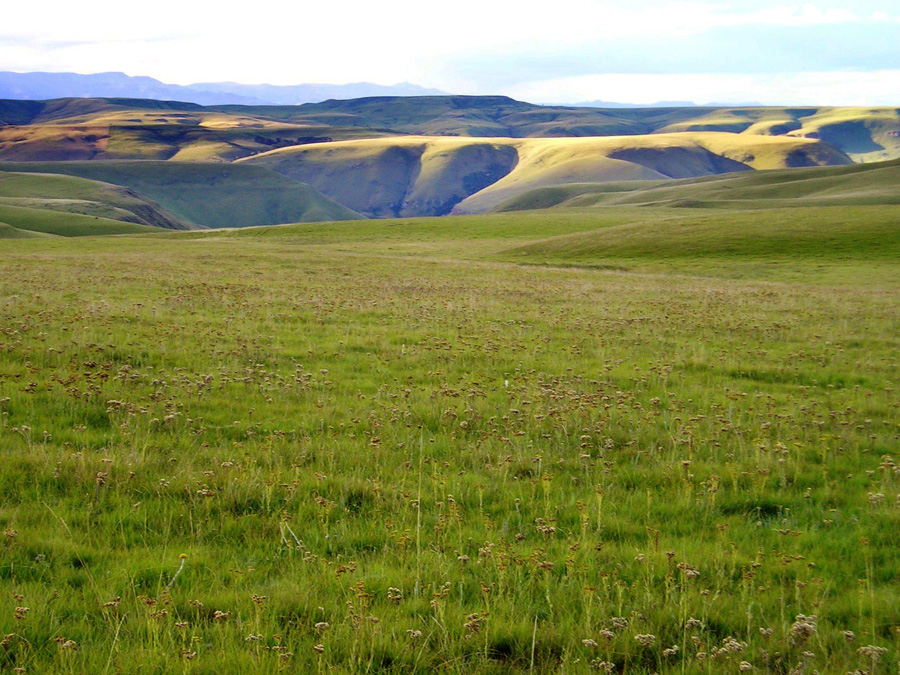
Landscape near Vrederus. Tom Sutcliffe photograph.
From what I could gather, Juan-Marie Naude is the lady in this area when it comes to fly fishing. Access to many, but not all the streams, is by way of a PG Bison (a forestry company) permit, that allows the bearer to fish the streams where they flow through their forests. So Vrederus is the best option for the newbie and besides, there's good stream water on and around the farm itself. We arrived at Vrederus after lunchtime and were greeted by the dogs, an enthusiastic border collie and a wee, white fluff ball that somehow identified me as a visiting fly fisher. I exchanged a few slices of biltong with them for what turned out to be a rewarding friendship for the remainder of the stay. Farm dogs are amongst the nicest you’ll meet. But I should define “farm” dogs here; true farm dogs are working dogs, like sheep dogs, shepherd dogs, gun dogs and the like. You need to be wary of these because they are workers and not pets. Indeed Basie Vosloo of Birkhall has a couple of Anatolian Sheep dogs that will make short work of you, but the house dogs are generally real friendly.
After unpacking heaps of tackle, food and whisky into Stonefly Cottage, Juan-Marie came over to give us some advice on the fishing and her husband, Donie, popped around later that evening, as is usual with most farmers in the region. They are lovely people and it’s easy to understand why their dogs are so friendly, but once again this is a generalization and if you find yourself poaching on private land don’t be surprised to end up with a butt full of birdshot!

Stonefly Cottage. Tom Sutcliffe photograph.
There are a number of streams to fish in the area including the Tsitsa, Luzie (on Vrederus), Antelope, Hawerspruit, Tentkop, the Swith on a neighbouring farm Honingkloof, and the Bradgate on a farm Donie leases. And there are even some unnamed streams that will appeal to the real adventurer. It truly is another region to discover as opposed to just another farm with a single stream. A topographical map of the region combined with access could keep you busy fishing for years!
The first morning we were up bright and cheerful, the weather rather warm for Autumn. Adventurously, we had opted to fish the Tsitsa at its headwaters. Farmer's directions were exchanged and we headed out, somehow knowing we would get a little lost. There is something pleasing about venturing out to new waters and when Juan-Marie gave us a hand held CB radio there was a sense that we would be heading somewhere remote, which buoyed up our enthusiasm and excitement. The directions included instructions that we should ask one of the farm workers for directions to the trail that heads down into the valley and after passing the farmhouse at the end of the road we spotted a tractor driver working the fields. Thanks to some clever hand signals and broken Xhosa he agreed to show us the way. He pointed and grunted from the truck as we continued on. There was some proper 4X4 work required here and I stopped a couple of times to make sure we weren’t driving off a cliff. Luckily the Hilux is a fairly capable truck and the 4X4 functions have ability well beyond climbing urban pavements, but he assured us in sign language that we were on the right path and in the end we stopped on the edge of an escarpment and he pointed at the stream below with a grin. I offered him a couple of chocolates, a bag of corn chips and a bottle of water for his trouble and he waved us on with a smile.
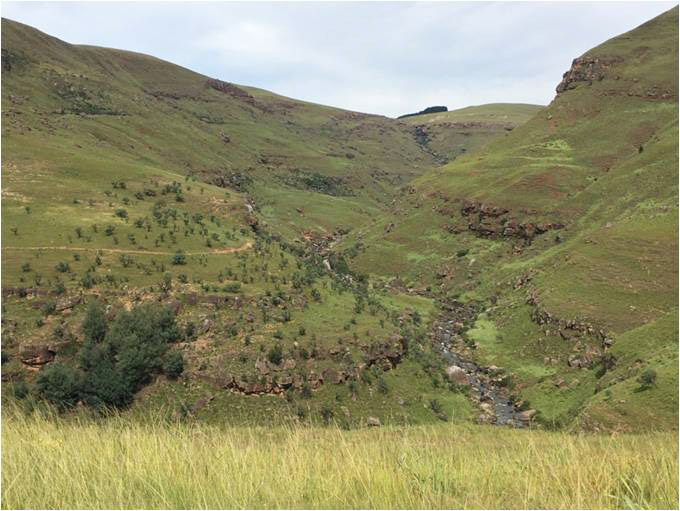
The Tsitsa River Valley
The headwaters of the Tsitsa are right up there with the most remote streams you’ll fish in the Eastern Cape highlands and access to the valley is gained by finding a ravine and then climbing down the canyon to the streambed below. This is wild fishing and not for a faint hearted fly fisher in felt soles. It quickly dawns on you why you get given a CB radio. It’s not for show, but I could think of worse ways to die. So after spending about twenty minutes trying to figure out a route and zigzagging my way down over rocks, through thorns and seeping ground I finally reached the bottom and couldn’t help but notice a definite wobble in my knees. The climb out was going to be a challenge. Ryan had chosen a different route and I hoped he had found a goat trail. He was going to fish upstream and so I hiked downstream planning to fish back up.
This is how I imagine a classic Berg stream to be; strewn with massive chunks of granite the size of small houses that had fallen from the cliffs above over eons of time. I looked up at the cliff slopes wondering when the next block would fall but didn’t ponder the thought for too long. The day was warm and it was a little humid in the valley. The bright, clear stream flowed and stepped through boulders and big square-faced rocks of all sizes, pooling in places with licks of current swerving around the rocks where there was a little gradient, and the surrounding landscape was far more vibrant than the freestone streams I normally fish. I’d like to say this was more pocket water, but that wouldn’t be an apt description because the scale of the place lacked the required intimacy. Indeed as I threaded my way downstream I had to do more rock climbing as the stream edge could not be navigated in parts. In addition, I tried to stay well back from the water until I was ready to fish. I always find gauging just how far to venture down a stream a little tricky. In the ideal world you would give yourself enough water to fish up until your climb out point as the light begins to fade. That’s another reason why fishing upstream is easier. I just keep going until I panic enough to quit before I have to stumble back in moonlight.
The water in most of these streams is delicate and supremely clear and once a run has been fished over, the trout are generally put down and don’t readily appear again for some time. So overlapping with someone ahead of you is out of the question. Anyhow, I hiked further downstream until I reached a small waterfall and decided that this was as good a place as any to start. I took a break, offloaded the pack and enjoyed a simple ham and mustard sandwich, opting to watch the water for a while before stringing up my rod. There were no rises and although I try my best to stick with dry flies, I resisted and tied on a brace of nymphs, a ZAK trailed by a smaller PTN. As I mentioned it had been a good while since I’d held a small, lively wild trout in my hand and this being the beginning of the trip it was still a bit of a numbers game, meaning my need to catch outstripped my need to fish. After a couple of roll casts and leaving the nymphs in the water for longer than I cared, as Tom suggests in Shadows on the Stream Bed, I promptly hooked and landed a little wild fish of no more than 8 inches. I was glad to make its acquaintance and stopped to admire its ink-black spots and par-marked flanks.
The day progressed all too quickly as I worked my way back up the Tsitsa and although the fish were scarce, I suspect I spooked way too many. I managed to winkle out a few truly wild trout up to 10 inches here and there, but not more than a half a dozen, then switched over to a Para Adams and caught one or two on dry fly, which is how I like it. But the weather and water seemed a little too warm and I never really got the measure of things. I put it down to rustiness. The real reasons for the scarcity of fish would only reveal themselves later in the trip and as I write this I can’t help but kick my own butt for not realizing it from day one. By the time I reached Ryan the shadows had grown long and we needed to face the hike out. He indicated that he hadn’t found a way in and after scouring the ridge for over an hour followed my route down. This meant that we would have to follow the same route to the top and looking up at the steep ravine with the rocks, thorny shrub and seeping ground I wasn’t overly confident we would make it back to the truck. But much like the little steam engine chugging along in, “I think I can,” mode, we somehow made it to the top. Smoking a pack of Marlboro cigarettes a day doesn’t help either!

The Tsitsa in the valley below. A pack of Marlboro a day doesn’t help the climb out. Photograph per Tony Kietsman.
One of the niceties of fishing these regions is the drive back at sunset to your lodgings. The vastness of the landscape in which you find yourself means that some drives can be an hour or so long. And because I’m not fully absorbed in the fishing I’m actually looking around drinking in the scenery. All around the mountain sky is full of pastel purples and oranges; high vantage points along the road provide breathtaking views and with sore muscles and a happy heart there’s a definite and warm sense of contentment that adds to my enjoyment.

All around the mountain sky is full of pastel purples and oranges. Tom Sutcliffe photograph.
The next morning we headed out to the Hawerspruit as recent reports were that it was fishing well. The access here was supposed to be from the road bridge, but we travelled a little further and found a PG Bison road that would take us downstream and close enough to provide more kilometres to fish. So I opted for this, as the water would have been less touched. We headed in and followed the network of roads that ran between pine trees that reminded me of my time in Canada, and then came on a large puff adder in the centre of the dirt road, an omen of things to come.

A big puff adder on the road to the Hawerspruit.
When we had reached the point where the road veered away from the stream we decided to park the truck and climb down into the valley.
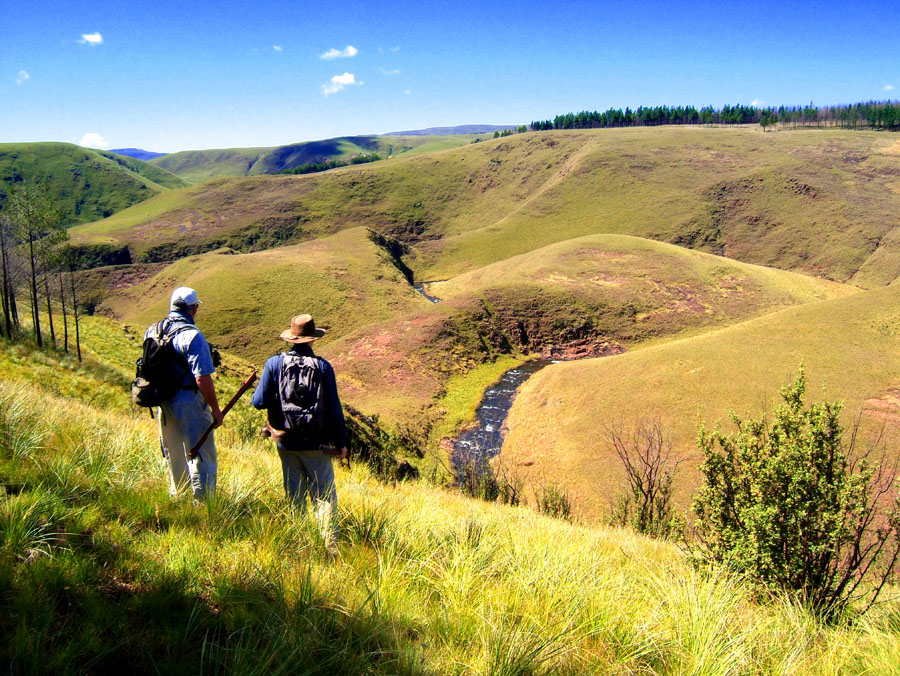
The Hawerspruit Valley. Tom Sutcliffe photograph.
Once again I told Ryan to fish up and I would head downstream. The Hawerspruit was flowing nicely and in the lower reaches the stream structure features bedrock bottoms that never offer the best fish-holding water. So I covered ground as fast as I could through the thick grass, noting some good holding water spaced between the long, shallow, bedrock runs. I spent the better part of an hour crisscrossing the stream and making good pace. When walking through veld I always have snakes firmly in my mind so when I ran into a herd of fallow deer lying next to the stream, they were nearly as startled as I was. They took off at an almost impossible angle straight up the mountain side, sounding an alert that was something between a scream and bird call. I watched them go. I like fallow deer. They are pretty and timid and much like trout, an alien species that have made largely inhospitable places home and to my mind have earned the right to stay. I pushed on thinking I had gone far enough when I nearly stepped on the black and yellow tail of a massive Rinkhals, a cobra-like snake. I stopped dead and it slid away. It must have been eight foot, which means around six feet after fright discount, and that was just the tail. Luckily I never saw the business end of it.
I stayed in the stream for the rest of the day. The fishing was only around those sections of the freestone stream where the bedrock had broken loose and piled up over time. The best I could hope for was one or two takes and then move on up. For once I had timed it rather well and I reached the climb out point more or less on schedule. Ryan and I decided to break out the gas burner on the streamside and boiled up a pot of coffee with stream water as the sun slipped behind the mountains. I love the simplicity of it, enjoying a fresh cup of coffee and a smoke whilst listening to the creaks of your joints after a long day hauling a fly rod around. It doesn’t get too much better. I had managed a couple of fish through the day, mainly on dry fly, but at optimistic count not more than a half a dozen, so the catching was hard as to be expected, but the day was delightful.
The following morning we headed off to the Bradgate Stream, on another perfectly hot and sunny day, and after what has been too long now, I finally decided to try out a new cane rod my nephew Shaun had imported. He found a bunch of them online that were relatively cheap but made on famous tapers. They were readily available and around seven or eight of them arrived a few months later. They are fantastic split canes, mainly 3/4wt’s, nicely made without any of the fanciness of other custom-built rods. So I viewed them more as working tools than ornate collectables. I have dabbled in the bamboo rod arena, but never really got into them in a big way, other than just appreciating their beauty and their representation of the rich history of the sport. I suppose what I’m trying to say is they intrigued me, but I never really saw any benefit over fishing a lightweight Sage for example. Anyhow, they have accompanied me on a number of trips, but because they are heavier weight rods and we are small stream addicts we tend towards going as light as possible. I never really went beyond packing them into the truck. On this trip I took one marked as a Thomas and Thomas Caenis, a 4wt. As I said the catching had been a little slow, so I thought perhaps a cane rod would enhance the fishing a bit.

The Bradgate above the bridge
The Bradgate is a little more off the beaten track, not that the tracks here are overly beaten, but access is easy. Parking at the bridge we agreed that this time I would fish up and Ryan would fish down. There was a trout or two at the bridge that spooked upon close inspection and this was heartening to see. I put the cane rod together and strung it up with a 4wt line. The leader had already been tied with 6x tippet attached in preparation for the trip to which I connected a Parachute Adams. Entering the stream I felt the coolness of the water against my legs. It felt right; cold and clear, something the other streams seemed to lack.
Having cast these cane rods in the garden they seemed ok, but I packed in my usual ultra-light graphite just in case. To my delight the rod cast beautifully and, dare I say it, fished better than anything I had cast before. The gentle cane filtered out my inbuilt casting flaws and the fly hit the mark nearly every time. It was a defining moment, as though I had fished the thing for years. It was forgiving, comfortably weighty and as smooth as soft butter. I really didn’t adjust my casting style much. The rod just fitted like a right-sized shoe. There was a comfort and a balance and sense I could easily throw a full fly line and shoot a twenty foot forward cast without loading the rod. I was as pleasantly stunned as I was delighted, so naturally the fish came, winkled out of tiny slots, miniature riffles and undercuts, bright fish, fat and full of fight. One even went fourteen inches although most were closer to eight to ten inches.
The stream was delicate, tight and tricky and yet the rod made it easy. I have read that cane rods shouldn’t go lighter than 4wt and the only other cane I have fished was a 2-wt. It was beautifully built but never felt quite right. But here I had luckily fallen on the perfect match between rod and line; the effect is an outfit that blows away anything else I fished with, and I have saved long and hard to buy some top small stream graphite rods, always holding the secret view that split cane was reserved for the elite few, pretty for sure, but not nearly as good as modern graphite. But on this day none of my graphite rods even come close to this split cane. Forget the beauty, the organic, historic bla bla bla, this rod is simply my best fishing tool by far. I’m not sure if I should say this out loud because perhaps the split cane guys actually know this and keep it a secret and secondly because it may lead to my lynching, but a good cane rod is vastly superior on small streams, especially with dry flies. I had my reservations about a 4wt, but the beauty of it is that an eight inch trout still puts a mean bend into the rod, so much so that a sixteen or eighteen inch fish is a scary thought. This resulted in a delightful day and although I ran out of stream fairly quickly as the upper reaches get overgrown with wattle and box willow and silted up, I had enjoyed one of the nicest days streamside for many seasons.
In the end I didn’t tally up more than a dozen fish, but two remarkable things had happened. First I became a bamboo convert and will fish this cane rod before any other and secondly, I realized that the fish were going to be closer to the head waters where it was cooler and where there was more freestone in bottom structure. The two pennies had dropped at the same time.
The final day we headed for the Tentkopspruit. Yet again it was sunny and warm. Insistent that we get as high up it as possible, Donie said he wasn’t sure of the access, but if we saw pine trees we could have a go and see how close we could get. He also added that hardly anyone had fished there for a long while. That just added to the intrigue. We found the stream and headed up into the mountains to try to find a way to get closer to the headwaters. We followed one of the tracks into the pines with the 4X4 lever firmly engaged, but the further we went the higher we got from the stream until I decided to climb out and walk to edge to try and get a bearing. I nearly stepped on a three foot long grass snake that reacted the way it should, which resulted in me reacting the way I should– we jumped back in unison. To Ryan it must have looked like a well rehearsed dance move. The snake shot off down the mountain leaving me pleased I was wearing my brown pants. There are plenty of snakes in these parts, so needless to say, a good pair of gaitors is firmly on my birthday wish list. After a cigarette we came to the conclusion that we wouldn’t be able to get too much closer to the headwaters without spending the rest of the day scouting around so I made the call to head back to the Hawerspruit instead, but this time to fish well up from the bridge to see if we could get even closer to the headwaters.
We found a second bridge above the road bridge over the Hawerspruit and this was as far as we could go without stopping in for lunch at the PG Bison site office. The stream was fairly tiny, but a few small rises at the bridge told me that it held trout. I strung up the cane rod, secretly hoping it would be just as good as it was yesterday and not just some fluke, a sentiment most fly fishers would understand. To my delight the stream was cool and packed with six to eight inch fish that climbed all over my dry fly. I fished a Para Wulff of sorts that I tie with peacock dubbing and a red head and they loved it, although I suspect that most flies would have worked. The little stream got tighter and tighter and my casts had to be accurate and straight, but the cane was not a fluke and I fished with ease and confidence even in the light breeze. I easily landed a dozen or more of these beautiful little wild trout and even got a couple that may have stretched to twelve inches. They were butter fat and so naïve. I couldn’t help thanking each one as I put it back.
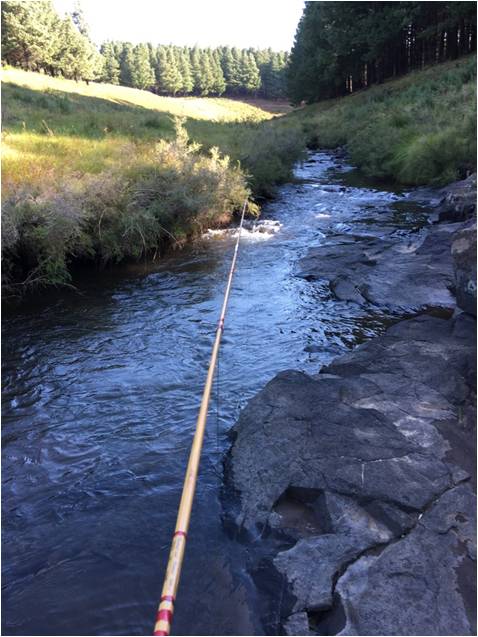
My bamboo fly rod leads the way up the Hawerspruit.
The stream varied and in some parts opened up and then closed in on the next bend. This stretch of the Hawerspruit could be referred to as Lilliputian water, but here and there it held some big pools and wider riffles that surprised me. I could have spent days traveling up it, and may still yet, but as the shadows grew long I knew the time had come to call it a day. I had gotten so engrossed in the stream, the rod and the fish that I wasn’t sure how far up I was. The day had turned out to be a gem and just the kind I needed to renew my faith in small streams, although in truth. my faith never really needed any testing. Part religion, part plain passion, there is no cure for my addiction to small stream fishing, but rather than admitting I have a problem, I'm rather proud of it!
Greg Carstens


